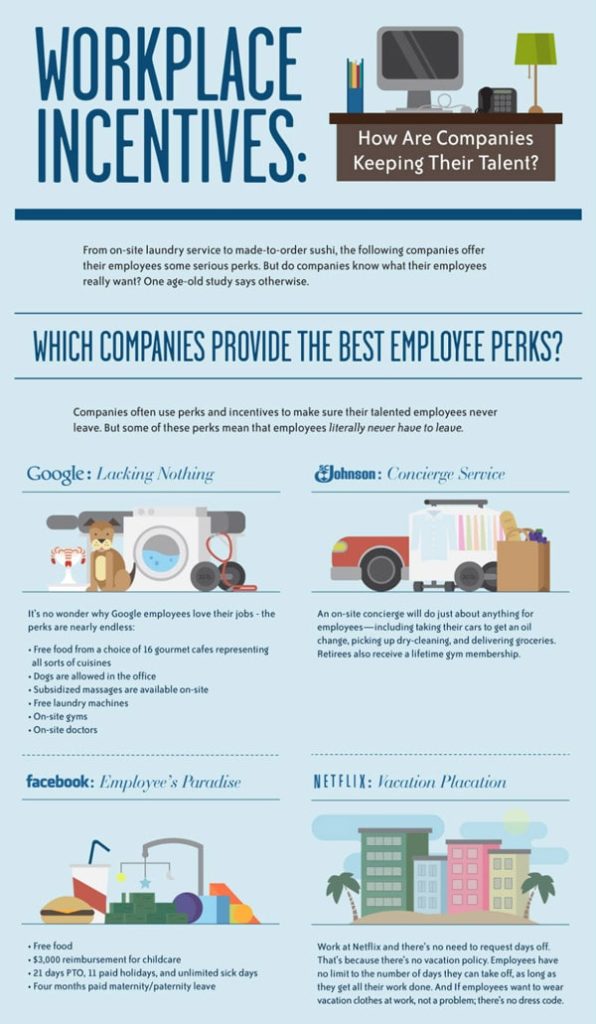Motivation is essential for employees and a healthy incentive program helps bolster extrinsic employees. The right employee incentive program can increase morale and contributes to employee well-being and productivity. However, creating a beneficial employee incentive program is not straightforward. There are relevant considerations to take into account when planning one.
This article will cover the benefits of an employee incentive program and what it should include.
Benefits of Employee Incentive Programs
Increase Morale in the Organization
Effective employee incentive programs increase the morale of the employees and keep them motivated. Create a positive work culture where employees are not treated as a means to an end but are valued and appreciated. Research shows that employee benefits increase productivity in the workplace. In addition to the compensation plan, you should also have perquisites, bonuses, health benefits, and other incentives.
Increase Engagement
Employees are at their best when they are engaged with their work. A disengaged employee will underperform and not think outside the work. Magic happens only when employees care about the tasks that they do. Employee incentive programs encourage employees to be engaged in their work and be good at what they do.
Attract Quality Hires
Excellent perks enhance the goodwill and reputation of an organization. Millennials and Gen Z want to work in places where the incentives are great. They want casual Fridays, holiday retreats, performance bonuses, gym memberships, and other perks. Therefore, employee incentive programs help attract quality hires.
Increase Loyalty Toward the Organization
Even with numerous opportunities available to employees, shifting companies is not an easy task. Employees only do so when there is a strong reason. Employee incentive programs can reduce and prevent employee turnover. Onboarding and training new employees costs companies nearly US$1100 per employee.
Types of Incentives for Employees
Monetary Incentives
Incentives paid out in money are called monetary incentives. These incentives directly affect the performance of employees as money is a crucial driving force for most people. The first and foremost monetary incentive is the basic pay and allowances people get.
After salary, there are various incentives such as profit sharing, performance bonuses, commissions, and fringe benefits; these add to the monetary incentive of the basic salary. They encourage people to perform and earn additional monetary incentives.
Although monetary incentives are huge motivating factors, they do not result in job satisfaction. Employees may be compelled to show up to work day-in and day-out, but they might be unhappy in doing that. Sooner or later, it can lead to burnout and less productivity.
A meta-study that analyzed 120 years of research showed that the relation between money and job satisfaction is very weak. However, money may not directly result in motivating employees. But the absence of monetary incentives leads to significant demotivation.
Non-monetary Incentives
Incentives that cannot be measured in monetary terms are called non-monetary incentives. The primary non-monetary incentive is the rank, authority, and responsibility a person has. Status enhances the self-esteem needs of employees.
Next, we have workplace culture. A culture where employees are valued is crucial. If employees are not appreciated and admonished at every turn, they will not stay long with the employer. Creating a positive work culture helps retain employees.
We have incentives such as challenging jobs as well. Oftentimes, it happens that employees have to do something that they find uninspiring. While routine assignments are important, there needs to be a balance between these assignments and challenging assignments. Employees need to be intellectually challenged now and then; otherwise, they will lose interest in their work. Moreover, companies can get the best out of their employees by giving them challenging tasks.
Job security is another non-monetary incentive that is vital for job satisfaction and motivation. An anxious employee cannot perform as well as he can otherwise. Employers should refrain from firing people without a solid reason. For example, a sick employee who has been absent for a while should not be fired. Instead, you should help them until they come back. This sends a message to other employees that you have their back.
Monetary and non-monetary employee incentive programs work in tandem to motivate employees. It might be tough to find a balance between the two.
Employee Rewards and Recognition Program Examples
Most employers ask the question “How to incentivize employees?” Well, here are 11 employee rewards and recognition program examples you can use to do so:
Appreciate Your Employees in Public and Criticize Them in Private
Appreciate your employees in public; they will feel that their hard work has paid off. Approximately 75% of employees say that simple words like “thank you” can boost company morale and motivation and help in promoting a good attitude at work.
Similarly, avoid admonishing employees in public as it damages their morale and projects them in a bad light in front of their colleagues. Negative motivators like this do not work. Instead, when they make a mistake, give them constructive criticism in private. Do not underestimate the power of simple things like these as they end up making the most difference. Work incentives like these do not cost a penny but are excellent morale boosters.
Profit Incentive
Profit-sharing can be a great tool to make employees feel valued. Set aside a percentage of your net profit and divide it equally among your employees. You can also give them the option to have their profits be contributed to their retirement account. The primary advantage of profit-sharing employee incentive programs is that employees will see themselves as owners. Moreover, they will feel that their performance will affect the profit of the company. Productivity and efficiency will increase company-wide. Profit-sharing programs are excellent incentives for employees.
Recognition for Loyal Employees
With the rising economy, employees have many more opportunities these days. They can shift to another company easily. This is why it makes sense to recognize employees that stay with you year after year. Giving perks and bonuses to employees every year they choose to stay with you is one of the most effective employee rewards programs you can have for retention.
Additional Paid Time Off Basis Tenure
Employees who have worked for more than five years in a company are considered long-tenured employees. One of the best benefits that American companies give their tenured employees is additional paid time off. Ensure that you have a robust tenure-based paid time off policy to improve attrition rates.
Health Benefits
Healthy and positive employees are more productive. Physical activity reduces cortisol, the stress hormone, and increases the production of endorphins and dopamine. Naturally, an energized employee who is stress-free will be beneficial for the organization. As such, you should have health incentive programs in place for employees. The employers pay the cost for a gym membership, Pilates, Yoga, and Zumba classes.
If you are looking for employee rewards ideas, this one is excellent. Company incentives such as this one have long-term positive effects on the well-being and productivity of the employees.
Retreats
Employee incentive programs should include holiday retreats. Sometimes, employees need to get away from it all. Holiday retreats are amazing workplace incentives as they help in team bonding. A short retreat can re-energize the employees and clear their heads. Plan team activities and games for them to create a getaway that will be agreeable to all employees.
Flexible Work Hours
The traditional 9-to-5 work hour does not work for everyone. Some employees perform better in the morning and some perform better at night. You can allow night people to arrive a little late and work. However, it is a given that they would have to be early if there’s a client or team meeting, or some other work. You would see an increase in the productivity and well-being of employees. If you want original and creative ideas, give your employees the option to choose their work schedule. Let them do their thing and focus on getting results.
Nearly 79% of employees that have flexible work hours say that they are satisfied with their work. In another survey, 68% of those with rigid work hours said that they were stressed, while only 20% of those with flexible work hours felt that way. Flexible work hours are one of the most reasonable and effective employee incentive ideas.
Casual Day
Incentive plans for employees should include casual days. A day every week, preferably Friday where employees can come casually is a huge morale booster. Start the weekend with your employees with a fun day for them. You can even give half the day off every casual Friday. We know that more work hours do not lead to increased productivity. Measure results by the work done, not the hours worked.
The new generation enjoys workplaces that let them keep a healthy work-life integration. Gone are the days where high salaries were enough.
Tuition Reimbursement
Encourage employees to increase their skill level by pursuing higher education. Tuition assistance will be a huge morale booster. It will signal to your employees that you want to invest in their future. Not only that, once they acquire new skills, you can even promote them. The reimbursement for education would also help employees boost their careers. For a diverse and inclusive workplace, this policy would go a long way.
Thus, ensure to include this policy in your employee incentive plan.
Bonuses
Money may not be the only thing employees look at anymore, but it is still a huge factor. A performance bonus can be a great motivator for employees. Nearly 65% of US employees reported that they prefer bonuses based on their performance. To be fair to employees, you need to set out objective criteria that determine who gets how much bonus.
Family Days
Offer employees family days in addition to their usual paid leaves. Employees will appreciate even one day every month. Your employee incentive programs should have family days to create a positive work culture that values togetherness and family. To make employees feel like family, you need to give them family days.
Celebrate your Employees
Celebrate the lives of your employees. Throw them a small party for their birthdays, give them a gift on their wedding anniversary, and congratulate them on their small wins. When a person starts working, work and life get intertwined. It is essential that your employee incentive programs celebrate your employees and aims to appreciate them. The programs should not just be a tool to increase productivity.
Fun Gifts
In employee retreats or during Christmas, you can give your employees fun gifts. Consider the interests and hobbies of your employees and give them a unique gift. A thoughtful employer encourages employees to go above and beyond for work. Your employee incentive programs can be spiced up with fun gifts.

Employee Attendance Incentive Plan
Productivity loss due to absenteeism costs companies US$225 billion every year. A healthy workplace prevents absenteeism. Use employee incentive program examples given above to reduce absenteeism and increase productivity. Additionally, a direct policy that incentivizes maximum attendance can be helpful as well. Employees who do their best to make it to work more often than others should be suitably rewarded.
However, you should also exclude the sick days and annual leave they take when calculating attendance. Otherwise, sick employees would show up to work and infect others.
Additional Leave Types
Paid time off is a huge perk but are you providing employees the right leave types? It isn’t just enough to offer sick and personal leave. You must go a step further and offer leave types like:
- Mental Health Days
- Bereavement Leave
- Sabbatical Leave
- Federal Holidays
- Parental Leave
- Compensatory Leave
What Employee Incentive Programs are Best for Your Business?
Employee incentive programs are vital for the well-being of the employees as well as employees. As Gen Z enters the workforce, HR is going to have to find out what makes them tick. As we cater to more generations our employee incentive programs must also diversify.
Every organization is unique. Design a program with the unique needs of your employees. All the best!




